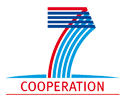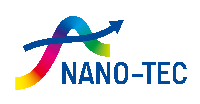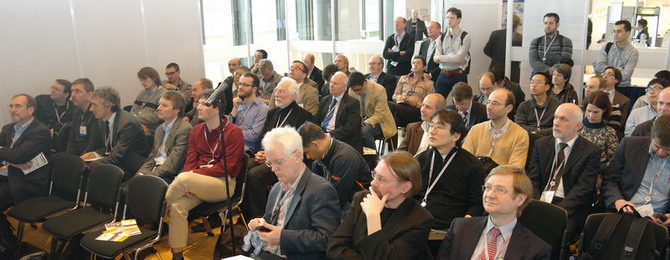

ICT-2010-257964
Speakers of the 1. WS on "Identification of the Main Requirements for Future ICT Devices"
Jeffrey Welser, International Business Machines, and Semiconductor Research Corporation, San José
Dr. Jeffrey Welser is on assignment from the IBM Corporation to serve as the Director of the Nanoelectronics Research Initiative (NRI), a subsidiary of the Semiconductor Research Corporation (SRC). The NRI supports university-based research on future nanoscale logic devices to replace the CMOS transistor in the 2020 timeframe. Dr. Welser received his PhD in Electrical Engineering from Stanford University in 1995, and joined IBM's Research Division at the T.J. Watson Research Center. His graduate work was focused on utilizing strained-Si and SiGe materials for FET devices. Since joining IBM, Jeff has worked on a variety of novel devices, including nano-crystal and quantum-dot memories, vertical-FET DRAM, and Si-based optical detectors, and eventually took over managing the Novel Silicon Device group at Watson. He was also working at the time as an adjunct professor at Columbia University, teaching semiconductor device physics. In 2000, Jeff took an assignment in Technology group headquarters, and then joined the Microelectronics division in 2001, as project manager for the high-performance CMOS device design groups. In May 2003, he was named Director of high-performance SOI and BEOL technology development, in addition to his continuing work as the IBM Management Committee Member for the Sony, Toshiba, and AMD development alliances. In late 2003, Jeff returned to the Research division as the Director of Next Generation Technology Components. He worked on the Next Generation Computing project, looking at technology, hardware, and software components for systems in the 2008-2012 timeframe. In mid-2006, Jeff took on his current role for NRI, and is now based at the IBM Almaden Research Center in San Jose, CA.
Jeong-Sun Moon, Hughes Research Laboratories, Malibu
Jeong-Sun Moon is a Senior Research Scientist at HRL, Malibu, CA. He received the Ph.D. degree in physics from Michigan State University, East Lansing, MI, 1995 in the area of quantum devices and digital signal processing (DSP). Using DSP, he developed a complete digital lock-in amplifier in 1992. Before HRL, he worked at Sandia National Laboratories in NM, where he worked on III-V semiconductor nanoelectronics and THz detection. In 2000, he joined the Microelectronics Laboratories of HRL Laboratories LLC, Malibu, CA. At HRL, he has been working on emerging materials/devices/RF circuits using GaN, InP, GaSb, SiGe and Graphene, as well as optical devices. He has been a PI for contracts from DARPA, ONR, NRO, JPL and NASA. He has authored or co-authored more than 60 papers, and presented numerous technical conferences and government-sponsored workshops. He received NASA Space Act Board Award in 2009. He holds 13 patents with 5 patents pending.
Livio Baldi, Numonyx-MicronTechnology Inc., Milano
Ing. Livio Baldi was born in Tortona (Alessandria) in 1949. He graduated in Electronic Engineering in 1973 at the University of Pavia. In 1974 he joined SGS-ATES (now STMicroelectronics), in the Central R&D of Agrate Brianza, working at the development of MOS and CMOS processes. He has been responsible for the development of CMOS processes for EEPROM memories and multifunction logic. In 1999 he has been put in charge of the NVM Design Platform Development Group, with the mission to provide design tools, design methodology and libraries support to the development of stand-alone and embedded Non Volatile Memories. From 2001 to 2008 he has taken the responsibility for the coordination of cooperation research projects, and represented ST-Italy in the MEDEA+ Steering Group-Technology and in the Support Group of the European Technology Platform (ENIAC). He has acted as consultant for the Commission in the definition of Framework Programmes and he is member of the Expert Advisory Group for Theme 4 (Nanoscience, Materials and Production Technology) of FP7. From March 31st, 2008 he has moved to Numonyx, the new ST-Intel joint venture on Flash memories, in charge of External Relations and Funding in Central R&D. He holds 32 US patents, 17 European patents, and is author of more than 65 papers and communications to conferences.
Helmut Graeb, Technische Universität München
Helmut Graeb got his Dipl.-Ing., Dr.-Ing., and habilitation degrees from Technische Universitaet Muenchen in 1986, 1993 and 2008, respectively. He was with Siemens Corporation, Munich, from 1986 to 1987, where he was involved in the design of DRAMs. Since 1987, he has been with the Institute of Electronic Design Automation, TUM, where he has been the head of a research group since 1993. He has published more than 100 papers, six of which were nominated for best papers at DAC, ICCAD, DATE conferences. His research interests are in design automation for analog and mixed-signal circuits, with particular emphasis on Pareto optimization of analog circuits considering parameter tolerances, analog design for yield and reliability, hierarchical sizing of analog circuits, analog/mixed signal test design, semi-discrete optimization of analog circuits, and structural analysis of analog and digital circuits. Dr. Graeb has, for instance, served as a Member of the Executive Committee and Tutorial Chair of the ICCAD conference, as a Member or Chair of the Analog Program Subcommittees of the ICCAD, DAC, and D.A.T.E conferences, as Associate Editor of the IEEE TRANSACTIONS ON CIRCUITS AND SYSTEMS PART II: ANALOG AND DIGITAL SIGNAL PROCESSING and IEEE TRANSACTIONS ON COMPUTER-AIDED DESIGN OF INTEGRATED CIRCUITS AND SYSTEMS, and as a Member of the Technical Advisory Board of MunEDA GmbH Munich, which he co-founded. He is a Senior Member of IEEE (CAS) and member of VDE (ITG). He was the recipient of the 2008 prize of the Information Technology Society (ITG) of the Association for Electrical, Electronic and Information Technologies (VDE), of the 2004 Best Teaching Award of the TUM EE Faculty Students Association, of the 3rd prize of the 1996 Munich Business Plan Contest.
Michel BRILLOUËT, Atomic Energy Commission, Electronics and Information Technology Laboratory, Grenoble
Michel BRILLOUËT joined CEA-LETI in 1999 where he managed a R&D division on silicon microsystems and from 2001 also on silicon microelectronics. He is presently strongly involved in the shaping of the European Research Area in nanoelectronics (ENIAC, etc.) and in bodies targeting international collaborations. He participates in international forums (ITRS…) and conferences (VLSI-TSA, INC…). Prior to joining CEA-LETI, BRILLOUËT worked for 23 years in Centre National des Télécommunications (CNET; France Telecom R&D Center) where he held different positions in microelectronics research. In 1992, he was assigned to the Common R&D Center between STMicroelectronics and France Télécom in Crolles, France, where he was in charge of all the technology R&D programs for the Crolles site, including CMOS, eDRAM and BiCMOS process and process integration along with their interaction with the design community. BRILLOUËT graduated from Ecole Polytechnique in Paris in 1974 and Telecom Paris in 1976.
Dirk Beernaert, European Commission
Dirk is an engineer in physics, in nuclear science and in material science (1976). After a short period working in statistics, he was involved as engineering and technology manager in setting up a laboratory to sustain the design of microelectronic components and subsequently in setting up a manufacturing site in micro-electronics to produce digital, analogue and high voltage components, where he was responsible for 20 engineers and for organising technology transfer between different organisations. He has joined the European Commission in 1990 where he has been responsible for research initiatives in micro-electronics under different European Frameworks (FP) for Research and for cooperation with the Eureka programs in that field. He also had responsibilities for setting up the workplan for research in e-work, e-business, ecommerce and for starting up and running a Unit and the Program dealing with ‘Integrated Micro and Nanosystems’ activities under Framework 5 and 6 including Microsystems, sensors, interfaces, displays and large area integration. He is recently made responsible for running within Directorate General Information Society the Unit of ‘nano-electronics and photonics’ dealing with the implementation of Framework 6 activities, with planning the future 7th Framework activities and with all related research, innovation stimulation and regulatory activities in these fields. Owner of 2 patents and close to 100 articles on diverse research topics, on commercialisation, on innovation and on research strategies mainly in the field of micro-nano-technologies and miniaturisation.
William Stanchina, University of Pittsburg
William (Bill) Stanchina is a Professor and Chairman of the Department of Electrical and Computer Engineering at the University of Pittsburgh (Pittsburgh, PA, USA). At Pittsburgh (PITT) since 2005, his research has been addressing several topical areas -- wide bandgap semiconductor devices for power electronics and for development of nano-electronic devices. Additionally he’s been applying LEDs and photonic detectors to applications in medical point-of-care diagnostics and tunable solid-state lighting. Prior to joining PITT, he was the Director of the Microelectronics Laboratory at HRL Laboratories LLC (formerly Hughes Research Laboratories) in Malibu, CA. In that position, he directed the research and development and low volume production of high frequency III-V compound semiconductor devices and circuits and other RF components for a variety of aero-space and commercial applications. His own research involved the early development of InP-based HBT ICs through the full maturation of that technology for production of highly reliable ICs. He was at HRL for 21 years. Prior to joining HRL, he had been a faculty member in EE at the the Univ. of Notre Dame after receiving his PhD from the Univ. of Southern California.
Sergio Valenzuela, Catalan Institute for Nanotechnology, Barcelona
ICREA Research Professor and Leader of the Physics and Engineering of NanoDevices group at the CIN2 (CSIC-ICN), Catalan Institute of Nanotechnology in Barcelona since 2008. He obtained his PhD in Physics at the University of Buenos Aires, Argentina, was a Postdoctoral Fellow and Research Associate at Harvard University and a Research Scientist at the Massachusetts Institute of Technology (MIT). He is recipient of the 2009 IUPAP Young Scientist prize in magnetism. His group focuses on the development of novel devices, which are designed to gain insight of specific physical properties of the system components, relevant both for fundamental reasons and applications at the nanoscale. His research interests span spintronics, quantum computation, and nanoelectromechanical systems (NEMS).
Paolo Lugli, Technische Universität München
Paolo Lugli graduated in Physics at the University of Modena, Italy, in 1979. In 1981 he joined Colorado State University, Fort Collins, CO, where he received his Master of Science in 1982 and his Ph.D. in 1985, both in Electrical Engineering. In 1985 he joined the Physics Department of the University of Modena as Research Associate. From 1988 to 1993 he was Associate Professor of "Solid State Physics'' at the "Engineering Faculty'' of the 2nd University of Rome "Tor Vergata''. In 1993 he was appointed as Full Professor of "Optoelectronics'' at the same University. In 2002 he joined the Technical University of Munich were he was appointed head of the newly created Institute for Nanoelectronics. His current research interests involve the nanoimprint lithography, the modeling, fabrication and characterization of organic devices for electronics and optoelectronics applications, the design of organic circuits, the numerical simulation of microwave semiconductor devices, and the theoretical study of transport processes in nanostructures. He is author of more than 350 scientific papers and co-author of the books "The Monte Carlo Modelling for Semiconductor Device Simulations" (Springer, 1989) and "High Speed Optical Communications" (Kluver Academic, 1999). In 2004, he served as General Chairman of the IEEE International Conference on Nanotechnology held in Munich. He is IEEE Fellow.
Goran Wendin, Chalmers University of Technology, Gothenburg
Göran Wendin is Professor of Theoretical Physics, APS Fellow, working on quantum computing and molecular electronics, currently on molecular transport and on functionalized nanoparticle-molecule networks (Nanocell) for postfabrication programming and (re)configuration. He has published 170 papers nearly 4000 citations (Hirsch index 34). He has been coordinator of EU FP5 consortia on molecular electronics (NANOMOL) and quantum computing (SQUBIT, SQUBIT-2), as well as the FP6 EuroSQIP integrated project on quantum computing. He is presently the coordinator of SOLID, FP7-IP (2010-2013) on quantum computing with super- and semiconducting electronics, and WP-leader in the FP7 Nano-ICT project NABAB.

